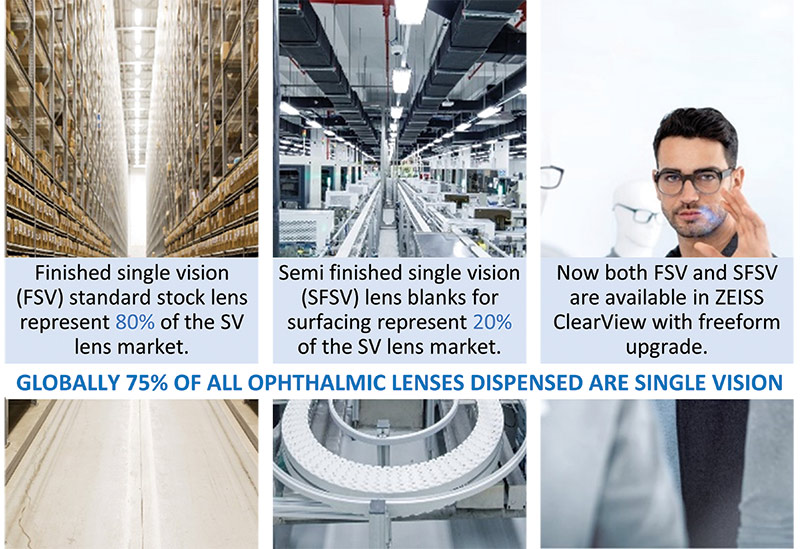Sponsored by ZEISS
By Preston Fassel
Once upon a time, one size didn’t fit most. While today, we are used to strolling into department stores and grabbing something off the rack that’s more or less our size, there was a time when clothing was tailored for the wearer. Although tailored is more arduous and expensive, it is a more fulfilling experience resulting in better fit and comfort. Rather than cinch our belts or end the day with impression marks from a pair of pants that’s a 34 when we really wear a 35 (but they don’t make 35), people had clothes that fit their particular needs and lifestyle. With the dawn of mass manufacturing, we accepted convenience and price over efficiency and ease of use, settling for acceptable. While we may not have the option of better fitting off-the-rack clothing, we have the option of better fit and comfort with ZEISS ClearView™ single vision lenses. ClearView lenses are freeform-optimized stock and semi-finished single vision lenses (SFSV) that provide better peripheral vision and visual comfort over old standard stock and SFSV lens blanks.
Just as with off-the-rack clothing, stock and semi-finished lens blanks worked, patients could see, but these standard single vision lens blanks came with visual compromise, poor peripheral vision due to lens aberration in standard SV lens blanks. Inventory requirements to match every Rx power with its ideal base curve is unfeasible. The range of Rxs used for a base curve falls outside the range for a best-form base curve, with the result being increased lens aberrations affecting visual clarity and limiting the clear field of view through the lens periphery that’s lost through the one-size-fits-all system.

For years, we’ve accepted it, patients and ECPs alike; stock lenses are quick and convenient for both patient and practice, and most folks would rather have acceptable vision as soon as possible than not be able to see at all. What’s a little peripheral distortion and blurring if you can see straight ahead to drive to the store or watch TV? Still, just because we accept something doesn’t mean we like it. Per a recent consumer survey, a whopping 100 percent of wearers said that it was extremely or very important to them that their lenses offer comfortable vision across the entire lens.
What’s more, upwards of 70 percent of all ophthalmic lenses have cylinder correction. Sphero-cylinder lenses have a spherical power meridian and a cylinder power meridian. This forces the lens designer of standard single vision lenses to compromise since standard spherical lenses have a single base curve and a toric (two curves) back surface. The lens designer had to choose whether to use the best-form base curve to minimize power aberrations in the spherical meridian or the cylinder meridian, or for a spherical equivalent (average of the sphere and the cylinder). So, what’s the answer? How can we offer patients upgraded single vision lenses without sacrificing the convenience of stock lenses or incurring the higher cost and complicated position of wear measurement needed for customized freeform lenses?
That’s the benefit of ZEISS ClearView, a new freeform lens design that uses 700 free parameters to optimize standard single vision lens blanks across one entire quadrant of the lens and then mirrored two times to cover the whole lens surface. Freeform design optimization is a giant leap in upgrading single vision stock and semi-finished lenses. As a result, ClearView achieves the cosmetic objective of a very flat and thin SV lens while achieving the optical performance upgrade that produces excellent lens optics from the lens center to the periphery. Utilizing cutting-edge technology developed by ZEISS in conjunction with the Queensland University of Technology in Brisbane, Australia, ZEISS ClearView was built by calculating key lens parameters for optimized vision and rendering them in a ZEISS Vision Clarity Simulation. Based on the thresholds defined in these studies, blur levels are classified into four distinct levels: the zone of excellent vision clarity providing the best clear vision, noticeable blur, troublesome blur and objectionable blur. The ZEISS Vision Clarity Simulation result can be further translated into visual acuity contour plots, which graphically depict the distribution of optical blur over the lens as seen by the wearer and show the deviation from the ideal central correction toward the lens periphery.
There’s a difference between “the best we have” and “the best that’s possible.” Building on a tradition of technological excellence, ZEISS ClearView allows the ECP to offer freeform optimized stock and semi-finished lens blanks to upgrade their single vision patients’ visual experience, and all with the ease and convenience of stock and semi-finished lenses of old.













